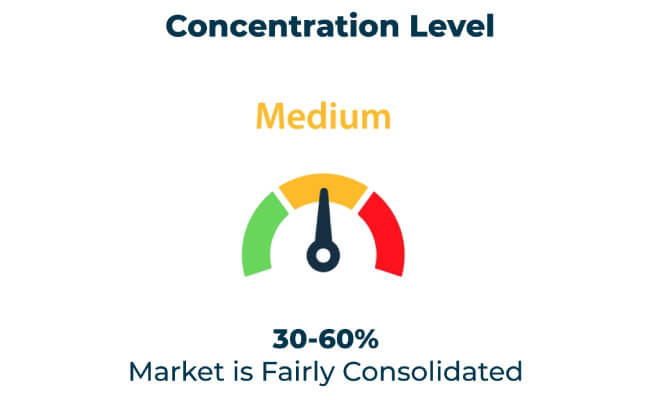The thin wall plastic container market is thriving as consumers and businesses demand lightweight, durable, and eco-friendly packaging solutions. Manufacturers are innovating with advanced materials, designs, and technologies to cater to industries like food and beverage, retail, and personal care.
As sustainability takes center stage, companies are prioritizing recyclable materials and energy-efficient production processes. Collaborations with key stakeholders ensure compliance with food safety regulations and environmental
Exclusive Offer: 30% Off on Regional Reports
Get a free sample report and customize your regions for a 30% discount on your regional report!
Factors Driving Market Growth
Global Market Share & Industry Share
| Category | Market Share (%) |
|---|---|
| Top 3 Players (Amcor, Berry Global, RPC Group) | 15% |
| Rest of Top 5 Players (Silgan Holdings, Huhtamaki) | 09% |
| Next 5 of Top 10 Players | 07% |
Type of Player & Industry Share
| Type of Player | Market Share (%) |
|---|---|
| Top 10 Players | 31% |
| Next 20 Players | 40% |
| Remaining Players | 29% |

Year-on-Year Leaders
Check Free Sample Report & Save 40%!
Select your niche segments and personalize your insights for smart savings. Cut costs now!
Emerging markets in Asia-Pacific, Africa, and Latin America present substantial opportunities for exporters. The rising adoption of packaged foods, urbanization, and increasing disposable incomes drive demand for high-quality thin wall containers. Exporters that align with local regulations and consumer preferences can capitalize on these growth areas.
In-House vs. Contract Packaging
| Region | North America |
|---|---|
| Market Share (%) | 30% |
| Key Drivers | Sustainability and food safety standards shape demand. |
| Region | Europe |
|---|---|
| Market Share (%) | 35% |
| Key Drivers | Recycling infrastructure and eco-conscious consumers lead. |
| Region | Asia-Pacific |
|---|---|
| Market Share (%) | 25% |
| Key Drivers | Rising urbanization and packaged food consumption drive growth. |
| Region | Other Regions |
|---|---|
| Market Share (%) | 10% |
| Key Drivers | Affordable, durable packaging gains traction in emerging markets. |
The thin wall plastic container market will grow through advancements in smart packaging, sustainability, and automation. Companies embracing material innovations and collaborating with e-commerce platforms will lead in capturing new opportunities. Expansion into emerging markets and alignment with global sustainability goals will drive further growth.
| Tier | Key Companies |
|---|---|
| Tier 1 | Amcor, Berry Global, RPC Group |
| Tier 2 | Silgan Holdings, Huhtamaki |
| Tier 3 | Greiner Packaging, Pactiv |
Key Vendor Initiatives
The thin wall plastic container market is on a strong growth trajectory, driven by sustainability, convenience, and technological innovation. Companies that invest in advanced materials, automation, and emerging markets will lead the industry. Collaboration with e-commerce platforms and adherence to environmental standards will further enhance market positions
Key Definitions
Abbreviations
Methodology
This report integrates primary research, secondary data, and expert insights. Analysts validated findings through interviews with industry professionals and end-users to ensure actionable insights.
Market Definition
The thin wall plastic container market includes the development, production, and use of lightweight, durable, and sustainable packaging solutions for food, retail, logistics, and personal care. These containers focus on sustainability, convenience, and customization.
Thin wall plastic containers are lightweight, durable packaging solutions made with minimal material usage. They are widely used in industries like food, personal care, and pharmaceuticals.
The demand is rising due to their sustainability, cost-efficiency, and convenience. These containers reduce material usage and logistics costs while meeting consumer and regulatory preferences for eco-friendly solutions.
The food and beverage industry is the primary driver, followed by personal care, pharmaceuticals, and industrial goods.
Manufacturers are adopting recyclable and biodegradable materials, optimizing material use, and using energy-efficient production processes to reduce carbon footprints.
Emerging markets in Asia-Pacific, Africa, and Latin America present significant opportunities, driven by urbanization, a growing middle class, and expanding food and retail sectors.
Key challenges include limited recycling infrastructure, fluctuating raw material costs, and navigating global regulatory frameworks.
Explore Packaging Formats Insights
View Reports
Thank you!
You will receive an email from our Business Development Manager. Please be sure to check your SPAM/JUNK folder too.